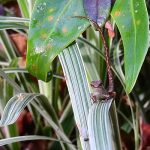WET TROPICS SHADE SKINK
The Wet Tropics Shade Skink
The Wet Tropics shade skink (Eulamprus tigrinus) is a fascinating lizard native to Australia, a quiet gem of the ancient rainforests.
Habitat and Distribution
- Location: The Wet Tropics shade skink is endemic to the Wet Tropics region of Queensland, Australia.
- Preferred Habitat: These skinks thrive in:
- Shaded, moist environments beneath the dense canopy of tropical rainforests.
- Along streams and creeks, nestled in leaf litter, under logs, or among stones, where coolness and moisture prevail.
- Range: They stretch from around Cooktown in the north to Ingham in the south, always within the lush, ancient rainforests.
Physical Description
- Size: Adults typically reach an average length of 16 cm, some slightly larger.
- Body: Sleek, streamlined form; scales are smooth and glossy.
- Colouration:
- Background is a bronze to olive-brown.
- Marked by distinctive dark stripes and spots, often reminiscent of a tiger’s pattern, which inspired the name
tigrinus. - The belly is usually pale cream or yellowish.
- Features:
- A long, tapering tail (often twice the length of its body).
- Limbs are well-developed, supporting agile movement through leaf litter.
Visual Insight: Imagine the dappled sunlight flickering through rainforest leaves, casting shifting patterns over a lizard whose own body echoes the shadows and light—a master of camouflage in a world of green and gold.
Breeding and Longevity
- Breeding Season: Typically occurs during the humid months from spring to early summer (September to December).
- Reproduction: The Wet Tropics shade skink is oviparous (egg-laying):
- Females lay small clutches of 2-5 eggs.
- Eggs are deposited in a safe, hidden location such as decaying logs, moist soil, or under rocks.
- Hatchlings: Young skinks emerge fully independent, miniature versions of the adults.
- Longevity: Although precise data are limited, they are believed to live 3-5 years in the wild, depending on predation and environmental factors.
Interesting Facts
- Thermoregulation: Unlike many lizards that bask openly, this skink cleverly utilises patches of filtered sunlight, making it less visible to predators.
- Role in Ecosystem: Acts as both predator (feeding on insects, spiders, and other small invertebrates) and prey (for birds, snakes, and larger mammals).
- Adaptation: Its subtle patterning and behaviour allow it to blend seamlessly with the rainforest floor, providing exceptional camouflage from threats.
- Conservation: While currently not listed as threatened, its survival is closely tied to the health of the rainforest ecosystem—a reminder of the intricate web of life dependent on habitat preservation.
- Behaviour: Primarily diurnal, it is most active during the cooler, humid parts of the day.
Conservation Note
The story of the Wet Tropics shade skink is intertwined with the ancient rainforests of northern Queensland. These forests are home to some of the world’s oldest lineages of plants and animals. Protecting this habitat not only preserves a single species but helps maintain a web of life millions of years in the making.
Summary Table
| Feature | Details |
|---|---|
| Range | Wet Tropics of Queensland, Australia |
| Habitat | Shaded, moist rainforest floor near streams and creeks |
| Size | Average 16 cm in length |
| Appearance | Bronze to olive-brown, dark stripes/spots, pale belly, smooth glossy scales |
| Diet | Insects, spiders, other small invertebrates |
| Breeding | Oviparous (egg-laying), 2–5 eggs per clutch, breeding season in spring to early summer |
| Longevity | 3–5 years (wild estimate) |
| Conservation | Not currently threatened, but dependent on rainforest preservation |
By knowing the Wet Tropics shade skink, we witness a story of adaptation, subtlety, and resilience, all harmonised with one of Australia’s most unique landscapes. Their continued presence reminds us of the importance of biodiversity and the quiet strength of even the smallest rainforest resident.

